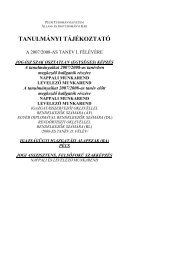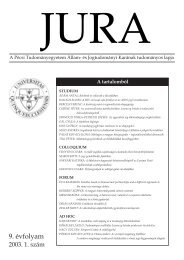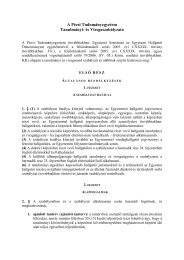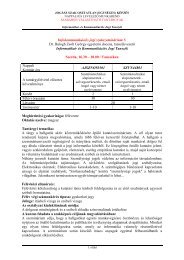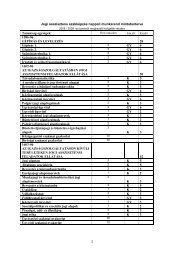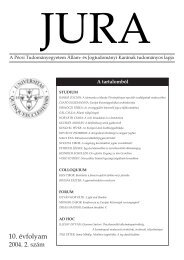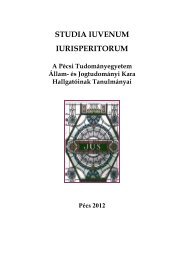2012. évi 2. szám - Jura - Pécsi Tudományegyetem
2012. évi 2. szám - Jura - Pécsi Tudományegyetem
2012. évi 2. szám - Jura - Pécsi Tudományegyetem
- TAGS
- jura
You also want an ePaper? Increase the reach of your titles
YUMPU automatically turns print PDFs into web optimized ePapers that Google loves.
240 Jorn van Rij: A Dutch Invitation: Hungarian Women Welcome?Hajjis and Magic Mushrooms. This eventually becamea legal nightmare as criminal law became moreinfluential and pro-active and suppressed the sethealth care goals. With this limitation of the healthcare legislation and goals, criminal law replaced theonce so noble protective goals by means that wereonce supportive but now became a goal in itself. Infact this means that when a process of criminalisationc.q. decriminalisation is not completed withina certain period it will linger and what follows is atime of uncertainty which eventually will act as astimulant for organised criminals to operate in thegrey sphere surrounding the process of legalisation.An example can be found in de Condone Policy asthe so-called back door approach has been left unnamed.This means the sale of marihuana by a coffeeshop is accepted, provided that the AHOJ-G rules 6and additional standards are uphold. The cultivationand supply of the marihuana however has been leftunregulated resulting in the situation that the influenceof organised crime is becomingly increasing.Because of this governmental action against thiscriminal behaviour is required and criminal lawwill be implemented as a short term solution. Asa result society is becomingly more and more willinglyor unwillingly subjected to the rules of criminallaw, minimising peoples’ freedom while this liberalconcept of freedom was once the basis for the entireDutch legalisation process.The growth of organised crime within Dutchsociety as a result of legislative hiatus has been asubject of growing interest ever since the 1980’s KlaasBruinsma era. 7 The turnover of these criminals wasestimated to run into the billions of Euros each yearand their influence into society grew rapidly. 8 Thesecriminals are commonly seen as octopi with tentaclesin all spheres of society, conducting all types of criminalbehaviour. A large part of their income is derivedout of the trafficking of Eastern-European womenwho are forced into a life of prostitution. The wordforced in this means more than having an enforcer,commonly a large unfriendly man, with a baseballbat standing outside of your window/rooms but italso implicates different types of grooming, seductionand trickery. 93. Peoples’ Perceptions of ProstitutionDuring the academic year of 2008-2009, 218 Bachelorof Law students for their course on criminologicalresearch methods conducted 5000 face to face questionnairesamongst people living in Rotterdam basedupon a non-probability stratified sample of the differentboroughs. Eventually 2419 questionnaireswere returned as being valid. The questionnairelooked into the Not In My Backyard (NIMBY) feelingstowards prostitution in relation to other more orless unwanted phenomena like a homeless shelter, arehab centre and a youth centre for troubled criminalyoungsters. Over 92% of the respondents weremost negative about having a red light district orother type of regulated prostitution area in their ownneighbourhood and 99% of the respondents whenasked if they would mind having one in their ownstreet. At the same time almost 86% of the respondentsdeclared to have a positive attitude towards theconcept of prostitution in Dutch society.Generally speaking we can assume Dutch societyis okay with the concept of prostitution as long asthis does not come too close to the sphere of everydaylife. This also portraits the general attitude stillpresent since the turnaround from the late 1970’swhen almost every one opposed to prostitution inneighbourhoods but 80% declared to have a positiveattitude.4. Hungarian Womenin the NetherlandsOver the period of September 2009 – September 2011,186 women working as prostitutes at several wellknow red lights districts in the cities of The Hague,Amsterdam and Groningen as well as women workingin a private surrounding in the city of Rotterdamin The Netherlands were interviewed. The mainfocus of these interviews was orientated towardstheir working position and the possibility for them toexit their current work environment. A great part ofthese interviews nevertheless also addressed issuesof nationality, travel and the working conditions ofthese girls.While working with this data, one striking factdrew attention. This was the situation that 97 of theinterviewed women, in the age range of 21 to 34,were originally from Hungary and more specific 56of them came out of the town of Szeged. The other 41women came either out of the city of Budapest or thesurrounding regions. It is estimated that the presenceof Hungarian women working within prostitutionin The Netherlands over the last five years has doubled.10 It is unclear if these Hungarian women belongto the Roma population but in general it is estimatedthat Roma women make up for 40% to 80% of all traffickedwomen from Hungary. 11 All the women havebeen working within the Netherlands for a period offive months up until two years. Before they startedworking in the Netherlands, 93 of them have workedin Hungary as a prostitute, more specific in BudapestJURA 2012/<strong>2.</strong>



